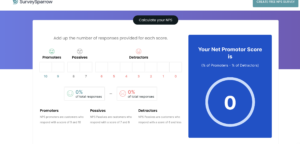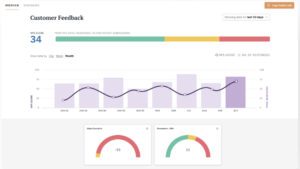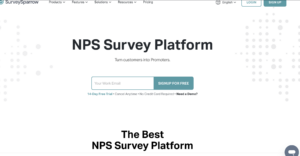What Is A Good NPS Score? The Breakdown, Calculation & Best Practices

Kate Williams
Last Updated: 13 December 2024
15 min read

Ever wonder, “What is a good NPS score, and why does it matter?” You’re not alone.
In the digital age, where customer opinions are as loud as billboards, understanding and leveraging your Net Promoter Score (NPS) can be your secret weapon to winning the market. It’s not just a metric; it’s a crystal ball revealing what your customers truly think about your brand.
In this no-fluff guide, we’re diving deep into the world of NPS. You’ll learn how to calculate it, interpret it like a pro, and use it to catapult your business to new heights. We’ll decode the mystery behind what makes a great NPS score and how you can achieve it. Plus, prepare for some insider tips and best practices that even the big players in your industry might not be using yet.
What is the NPS score?
First, it’s crucial to understand the overall concept of NPS and its structure.
The Net Promoter Score (NPS) is a widely used market research metric that gauges customer loyalty and satisfaction with a company’s product or service. It’s based on a single survey question that asks respondents to rate the likelihood of recommending the company, product, or service to friends, family, or colleagues on a scale from 0 to 10.
Why NPS Matters: Your NPS score is more than a number; it’s the pulse of your customer satisfaction. A high NPS means customers love your service or product enough to recommend it to others, a sign of true customer loyalty and a predictor of business growth.
NPS revolves around measuring customer loyalty and brand advocacy, meaning understanding what the customers think about your brand and how highly they rate it. It’s one of the most straightforward metrics requiring a simple question to gauge customer loyalty. That simple question is generally,
“On a scale of 0-10, what’s your likelihood of recommending our product/service to your family and friends?”
The customers give their responses to the question upon which they’re categorized into three groups;
Respondents are categorized into three groups:
- Promoters (score 9-10): These are delighted and loyal customers likely to recommend the product or service.
- Passives (score 7-8): These customers are satisfied but not enthusiastic enough to be promoters.
- Detractors (score 0-6): Dissatisfied customers who may not recommend the product and could potentially damage the company’s reputation through negative word-of-mouth.
How to Calculate NPS?
You know the overall concept and structure of NPS now. So, what is a good NPS score? You ask again. We share your sentiment, but is it worth your time to know a good NPS score without knowing how to calculate it?
Sure, you can use SurveySparrow’s NPS calculator, but being the curious personas we are, we’ll be interested to know the math behind this simple yet effective metric. That’s why let us quickly answer the question on calculating net promoter score, and we’ll get to the good part then (literally!).

Ok, let’s take a step-by-step process here:
- First, find the total number of customers who’ve responded to the NPS survey.
- After that, segregate the number of promoters and detractors.
- It’s time to find the percentage of Detractors now. For that, divide the total number of Detractors by the total respondents and multiply by 100.
- The next step involves doing the same for Promoters. Divide all promoters from the total respondents and multiply by 100.
- Subtract the percentage of Detractors from the percentage of promoters to procure the overall NPS. This is how the net promoter score calculation works.
So, the final NPS score comes from = % of Promoters – % of Detractors
For example, 150 customers responded to your survey, of which 70, 30, and 50 are the promoter, detractors, and passives split.
So, the percentage of promoters is 46.6%, and of detractors is 20%.
Therefore, the NPS is 46.6% – 20% = 26.6%
Voila! Here you go! Your overall NPS is 26 in a range of -100 to 100. And it cannot be 26.6, as NPS is always displayed in whole numbers. It’s a cinch stuff that way.
Explore Deeper Customer Insights with SurveySparrow
Try it for Free!
14-Day-Free Trial • Cancel Anytime • No Credit Card Required • Need a Demo?
What is a Good NPS Score?
A “good” Net Promoter Score (NPS) can vary significantly depending on the industry and market context. However, as a general rule of thumb, an NPS can be interpreted as follows:
- Above 0: Generally okay, indicating that a business has more promoters than detractors.
- Above 20: Good, showing a healthy balance of customer satisfaction.
- Above 50: Excellent, reflecting a strong, customer-focused company.
- Above 70: World-class, indicating exceptional customer loyalty and satisfaction.
It’s important to understand that these benchmarks are not absolute. What constitutes a good NPS score can differ greatly between industries. For example, a score considered excellent in one sector might be just average in another. For instance, industries like luxury goods or high-end services might naturally have higher NPS benchmarks. In contrast, sectors with traditionally lower customer satisfaction rates, like telecommunications or utilities, might have lower average scores.
What is a Good NPS Score for a Company?
Determining what constitutes a “good” Net Promoter Score (NPS) for a company largely depends on the industry context and market standards. While there’s no universal benchmark, here’s a general guideline to help you interpret NPS scores:
- Above 0: This is considered acceptable. It means that your business has more promoters than detractors. However, there’s still room for improvement.
- Above 20: This is viewed as favorable. It indicates a healthy number of promoters relative to detractors, suggesting positive customer sentiment.
- Above 50: This score is excellent. It signifies a strong, loyal customer base and indicates that the company is doing well in customer satisfaction.
- Above 70: This is an exceptional score, often considered world-class. It implies exceptionally high customer loyalty and satisfaction.
Remember, these are broad guidelines. The interpretation of a good NPS can vary between industries. To accurately assess whether your NPS is good, it’s best to compare it with industry-specific benchmarks.
Industry Specific BenchMarks
| Industry | Average NPS Benchmark (2024) |
|---|---|
| Hospital & Health Care | 58 |
| Computer Products & Network Security | 34 |
| Marketing & Advertising | 44 |
| Accounting | 72 |
| Apparel & Fashion | 72 |
| Broadcast Media | 15 |
| Building Materials | 81 |
| Education | 66 |
| Real Estate | 30 |
| Luxury Goods and Jewellery | 45 |
| Technology Companies | Not specified |
| Financial Institutions | Not specified |
Please note that these benchmarks are specific to 2024 and can vary from year to year. Also, the scores for some industries like Technology Companies and Financial Institutions, are not explicitly mentioned, but these sectors have shown trends of high customer satisfaction and loyalty.
Absolute NPS vs. Relative NPS
The Absolute and Relative NPS methods are the two ways to determine whether an NPS score is good. One uses the aforementioned industry benchmarking, and the other doesn’t. And it’s really up to you to choose the method you wanna go with.
Let’s understand a bit more about the two before you make a decision here;
Absolute NPS Method
Using this method, if your score dips below 0, i.e., a negative NPS, you have more detractors. In that case, most of your existing customers won’t prefer recommending your brand.
This method considers the absolute numbers, making the negative NPS scores a sign of more detractors and a score of 50+ is a sign of more promoters—anything in between means that you have a majority of passive customers.

Relative NPS Method
Using the Relative NPS outlook, comparing your brand’s NPS score with relevant industry benchmarks becomes the key to deciding if the NPS score is good compared to competitors. Simple and straight, what say?
What is a Good eNPS Score?
Employee Net Promoter Score (eNPS) is a metric to gauge employees’ willingness to recommend their workplace to friends or acquaintances. Like the Net Promoter Score (NPS) used for customers, eNPS helps measure employee satisfaction and loyalty.
The scoring for eNPS typically follows the same 0-10 scale, with respondents categorized as Promoters (9-10), Passives (7-8), and Detractors (0-6). The NPS is calculated by subtracting the percentage of Detractors from the percentage of Promoters.
Understanding what constitutes a “good” eNPS score is less straightforward than customer NPS, as it can vary significantly across industries, regions, and company sizes. However, here’s a general guideline:
- -10 to 10: Considered an average score. It indicates a relatively balanced mix of promoters and detractors.
- 10 to 30: Viewed as good. This range suggests a healthy level of employee satisfaction.
- 30 to 50: Regarded as excellent. A score in this range indicates a very positive employee sentiment.
- Above 50: Exceptional. This rare achievement signifies an extremely strong and positive employee culture.
How do You Analyze and Calculate the NPS Score with SurveySparrow?
- Conduct a Customer Survey: Ask customers how likely they are to recommend your product/service on a scale of 0-10.
- Categorize Responses: Classify customers as Promoters (9-10), Passives (7-8), or Detractors (0-6) based on their scores.
- Calculate NPS: Subtract the percentage of Detractors from the percentage of Promoters.
- Utilize SurveySparrow Tools: Use SurveySparrow’s online calculator or NPS survey software for easier calculation and analysis.
- Analyze Data: Examine the NPS score and feedback to understand customer loyalty and areas for improvement.
- Close Feedback Loop: Address issues highlighted by Detractors and use insights from Promoters to improve.
- Monitor Continuously: Track changes in NPS over time to gauge the impact of your customer experience strategies.
After having covered the major and the interesting topics, this is what remains: How do you make and analyze an NPS survey using SurveySparrow?
Why SurveySparrow? Well, it offers the most robust and powerful NPS feedback software to collect ratings from your customers and calculate NPS proactively. Read this success story to know how exactly it can help your company.
Get everything about NPS resolved at SurveySprrow. Know more
14-day free trial • Cancel Anytime • No Credit Card Required • No Strings Attached
10 Steps to Create a NPS Survey using SurveySparrow

Step 1: Click + New Survey on the top right corner of your survey dashboard and select NPS Survey.
Step 2: Modify the survey title and click Next.
Step 3: You can edit your NPS question to add variables like contact details or custom variables. Add the dollar sign($) next to your question.
Step 4: You can customize the label texts and enable segmenting your scale to mark promoters, passives, and detractors. The colors are customizable, too.
Step-5: For the open-ended follow-up question, edit as required and use question piping to pipe the respondents’ NPS scores into the question.
Step 6: Enable the ‘Question Text by Rating’ option to send individual follow-up questions to Promoters, Passives, and Detractors.
Step 7: Click +Add New to add more follow-up questions to your survey. Pick from the Multiple Choice, Rating, and Text question types.
Step 8: Add a Thank You page to your survey and personalize it using custom variables if you’d like. That’s it! You have now successfully created your NPS survey!
Step 9: Share it with your customers, and once all the responses are populated, head to the Results section and select the Overview tab. You’ll see the NPS score at the top.
After getting all the scores, here’s how you can analyze them using different options using SurveySparrow’s NPS solution;
Step-1: Under Overview in the Results section, you’ll see a trend of NPS responses over time. Adjust this trend to show daily, weekly, monthly, quarterly, or year-long responses.
Step-2: Widgets help you dissect your data better and gain deeper insights into the business. Select any of the widgets by merely clicking on the box or the Add Widgets button. Read this to know more about it. And for the time being, here are the widgets we have;
- Gauge Chart
- NPS Comparison
- Word Cloud
- Trend Graph
Get access to pre-made NPS survey templates for free.
14-day free trial • Cancel Anytime • No Credit Card Required • No Strings Attached
NPS Best Practices To Follow In 2024 And Beyond
Now, you know how to create and analyze NPS surveys fast and efficiently, but are there some best practices to follow, too? The answer is yes, and here’s what we have in the bag for you;
- Personalize the Survey: Start by addressing the customer by their first name to create a more personal and engaging experience.
- Send Timely Surveys: Distribute NPS surveys immediately after a customer interaction to get prompt and genuine responses.
- Include Detailed Questions: Beyond the standard NPS question, ask specific questions to understand the reasons behind their score.
- Optimize for Mobile: Ensure the survey is mobile-friendly with an intuitive and visually appealing design.
- Keep Email Invitations Brief: The email accompanying the survey link should be concise to encourage more opens and responses.
- Maintain Professionalism: Use your company’s logo and address in the survey to establish trust and professionalism.
- Follow-up for More Insights: Add open-ended follow-up questions to get detailed feedback. Phrases like “Why did you give us this score?” can be effective.
Extremely Common (Yet Important!) NPS FAQs
Before we wrap up this ‘What is a good NPS score’ article, here are the common yet crucial NPS FAQs you should know the answers to
#1 How accurate is the Net Promoter Score?
Very. The Net Promoter Score was developed after testing various questions to find the best alignment with customer loyalty. Fred Reichheld and Bain & Company further developed and eventually trademarked it. And many argue that it is by far the best customer loyalty metric in the market and the most accurate one, too.
#2 Do I need to send the NPS survey after every purchase?
No, if you want to understand your brand’s customer loyalty, sending an NPS survey every quarter or every six months works best. However, an NPS survey after every purchase will work if you want to know their loyalty towards a specific product.
Generally, NPS is meant to gauge customers’ loyalty to your brand. Hence, sending it out after every purchase would be an overkill without giving grand results. Stick to a definitive timeline of 3,6, or 12 months for these surveys to work best.
#3 Is Net Promoter Score a percentage?
No – Rather, NPS is the difference between two percentages (percentage of Promoters less percentage of Detractor). It generates a score between -100 and +100, based on the size of your promoters and detractors compared to the overall survey takers, but it’s not a percentage.
#4 Is it easier to convert a Detractor or a Passive to a Promoter?
Well, that’s debatable. But from our experience of having conducted hundreds of NPS surveys, we would say yes. It is easier to convert a Passive to a promoter compared to a Detractor. Because passive customers aren’t dissatisfied with your brand like the Detractors are, they will come along to be your brand’s Promoters if you start engaging with them the right way.
However, the risk of never hearing from a Passive customer is also real, which makes people state that Detractors are easier to convert than Passive customers because they stick with your brand and give you a second chance.
#5 Is an NPS score of 70 good?
As we mentioned, the answer to ‘what a good NPS score is depends on your company’s industry. So, an NPS score of 70 is outstanding if yours is a real-estate entity and alarmingly low if you’re in the hospitality business. The industry benchmarks bring more meaning to your NPS scores, and rightly so.
#6 What is a Good ENPS Score?
Employee Net Promoter Score (eNPS) is a metric used to gauge employees’ willingness to recommend their workplace to friends or acquaintances. Similar to the Net Promoter Score (NPS) used for customers, eNPS helps measure employee satisfaction and loyalty.
The scoring for eNPS typically follows the same 0-10 scale, with respondents categorized as Promoters (9-10), Passives (7-8), and Detractors (0-6). The eNPS is calculated by subtracting the percentage of Detractors from the percentage of Promoters.
Understanding what constitutes a “good” eNPS score is less straightforward than with customer NPS, as it can significantly vary across industries, regions, and company sizes. However, here’s a general guideline:
- -10 to 10: Considered an average score. It indicates a relatively balanced mix of promoters and detractors.
- 10 to 30: Viewed as good. This range suggests a healthy level of employee satisfaction.
- 30 to 50: Regarded as excellent. A score in this range indicates a very positive employee sentiment.
- Above 50: Exceptional. This rare achievement signifies an extremely strong and positive employee culture.
The Ball’s In Your Court!
If you do build a great experience, customers tell each other about that. Word of mouth is very powerful. – Jeff Bezos
Isn’t Jeff completely right here? Customers do tell each other about their fantastic experiences with a brand. And an NPS survey is how to know about that. Organizations, however, score very low NPS. Why? Well, because they don’t even bother conducting timely customer loyalty checks. Like our ambitious female entrepreneurs from the intro, they’re busy thinking about sales and profits.
It’s crucial, we get it, but so is your brand’s identity that a customer can relate it. Otherwise, a transactional customer relationship won’t give your business the wings of sustained growth. An NPS survey isn’t the solution to all your customer loyalty problems. It’s a way of getting to the solution, especially in this much-changed post-pandemic world.
Here’s hoping you make full use of this metric. For any help, literally any assistance, we’re here for you. Keep growing!

Kate Williams
Product Marketing Manager at SurveySparrow
Excels in empowering visionary companies through storytelling and strategic go-to-market planning. With extensive experience in product marketing and customer experience management, she is an accomplished author, podcast host, and mentor, sharing her expertise across diverse platforms and audiences.

Turn every feedback into a growth opportunity
14-day free trial • Cancel Anytime • No Credit Card Required • Need a Demo?




